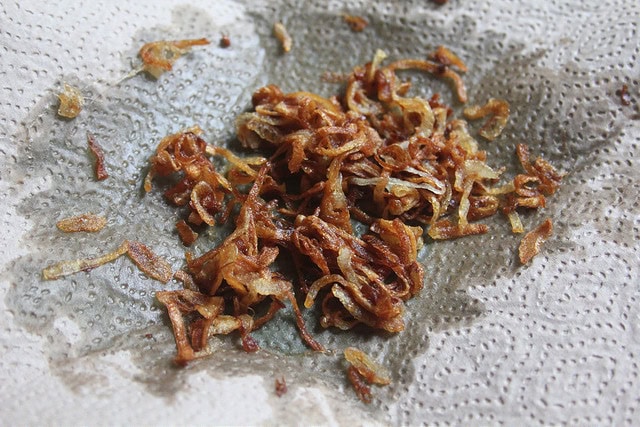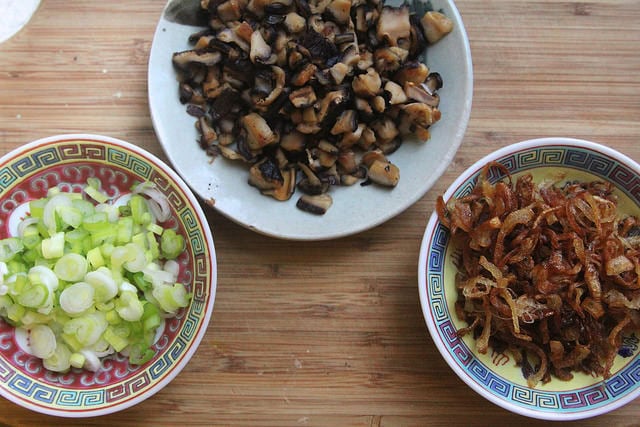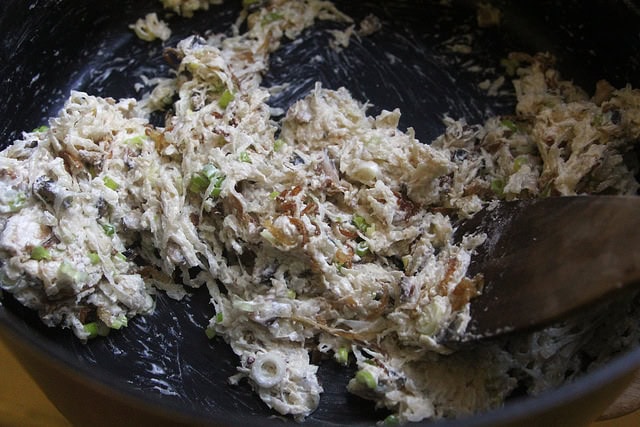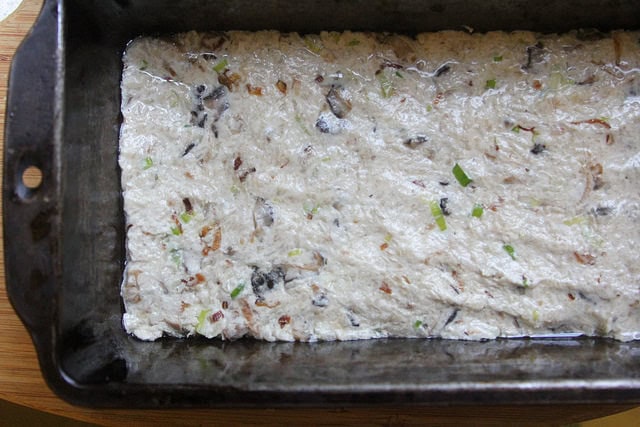![]()
The Lunar New Year is upon us—tomorrow marks the start of the Year of the Rooster. This is my year. I’m a rooster, and if you’re familiar with the Chinese calendar, you could deduce that I will be turning 24, 36 or 48 this year. I’ll let you figure it out. In Chinese horoscope theory, it’s supposed to be an unlucky year for you when it’s your year. Funny, it seems that it’s been unlucky for a lot of folks so far. Particularly people of color, LGBT folks, Muslims and immigrants. Oh, and women. I do not blame this on the Year of the Rooster, if you catch my drift.
Incidentally, mom is an immigrant. It’s no big deal. But it’s why I grew up eating stuff like pan-fried turnip cake (lobo gau), and love it enough to cook myself. This Cantonese snack can be found at most every dim sum brunch, and from what I’ve seen, it’s among the most popular, accessible bites at the table every time. It’s appealingly crispy, mild on the palate, and soft enough for babies with no teeth to eat. It’s also commonly enjoyed on Chinese New Year, thought to help bring in good luck. Let’s all hope so as we try making it at home!


Now, this recipe is not easy nor is it quick. Click over to the Stir-Fried Noodles with Winter Vegetables for one that is, and is fitting for Chinese New Year as well. But if you have some time, it makes a fun log ‘o stuff that you can slice up and pan-fry quickly for a tasty snack or party appetizer.
I’d never made it at home before; as with many dim sum specialties, it’s complicated. That’s why going out for dim sum is so special, because you get a whole variety uniquely tasty dumplings, rolls and stuff that would be a ridiculous feat to attempt in the home kitchen. But if making just one, that’s okay. Especially for a holiday like Chinese New Year.

Usually, turnip cake is studded throughout with tasty morsels, like little nubbins of Chinese sausage and dried baby shrimp. But I decided to try making a vegetarian version of it instead so all kinds of party-goers could enjoy it (it happens to be gluten-free, too). To make up for that lost umami, I enlisted some shiitake mushrooms and crispy-fried shallots for bits of all-plant based texture and flavor. Those and some fresh chopped scallions. There are a lot of other things I suppose you could add, so just have fun with it. Perhaps some dried daikon radish if you’ve got (it’s a classic addition).
After mixing these up with some shredded daikon radish (aka “turnip” here), rice flour and liquid, it’s poured into a greased loaf pan. The trickiest part is finding something large enough to steam it all in. Turnip cake must be steamed until set; then it’s pan-fried once firm enough to slice. My loaf pan just barely fit inside my largest pot. Try a smaller pan or mold of some sort that doesn’t necessary have to be loaf-shaped if yours doesn’t.


The inside of the cake turns somewhat translucent and gummy in texture once steamed through; it’s then almost always pan-fried until the surfaces of each slice are crisped to a brown. (Gummy-textured rice cakes like nian gau are also omens of good luck, commonly eaten on Chinese New Year, too.) These pan-fried slices of turnip cake are usually served with a dollop of oyster sauce on the side.
Even though I’d never had a vegetarian turnip cake, certainly none with fried shallots that I can recall, this homemade version sated my cravings for this classic snack just fine. And I hope it will delight anyone who might try it this way for the first time, too.
You don’t have to be Chinese to celebrate Chinese New Year, after all—least of all not through enjoying its food. Who wouldn’t want to partake on such a delicious occasion, borrowed from our immigrant friends and neighbors? That’s what makes our food and culture so much richer and better—and, just who we are.
Vegetarian Turnip Cake with Shiitake Mushrooms & Fried Shallots
(makes 1 9” loaf, or 10-12 servings)
2-3 small shallots, thinly sliced
½ cup vegetable oil, or another neutral cooking oil
5-6 dried shiitake mushrooms
2 cups packed shredded daikon radish
2 cups rice flour
1/2 tablespoons cornstarch
1 teaspoon salt
½ teaspoon white pepper
2-3 scallions, chopped
oyster sauce, for serving
Soak the mushrooms in warm water to cover for at least 15 minutes, or until fully reconstituted. Retain soaking water.
Heat the oil in a small pot. Once hot enough to sizzle when a shallot slice is dropped in, add a small handful of the sliced shallots and stir. Watch the pot, stirring occasionally, and just when the shallots are turning slightly golden, remove all of them with tongs from the pot and place on a paper towel to drain. Continue with the remaining batches of shallots until all are fried.
In a large pan or wok, add a couple tablespoons of the frying oil and all the grated turnip. Add the salt and white pepper and the soaking water from the mushrooms and cook, stirring occasionally, for 10 minutes or until the turnips are almost translucent.
Trim the stems from the mushrooms and finely chop them. Add the rice flour and cornstarch to the shredded daikon mixture and stir to combine thoroughly. Fold in the chopped mushrooms, scallions and fried shallots. Finally, add about 1 cup of water, until the mixture resembles a thick porridge.
Prepare a steamer contraption; this could be a large pot or Dutch oven with a lid, with an upturned heatsafe bowl or steamer rack on the bottom. Add enough water to fill the bottom by 3 inches or so, cover, and bring to a boil.
Pour the cake mixture into a greased pan THAT FITS INSIDE THE STEAMING CONTRAPTION WITH THE LID CLOSED. If a loaf pan doesn’t do it, then try a pie pan or something else. Once the steaming water is nicely boiling reduce heat to low so that it’s at a low simmer, and place the pan of turnip cake on top of the rack or bowl. Cover the lid. Let steam for 30 minutes. Check on it, and if the cake appears slightly more translucent and feels set throughout, remove and let cool.
Once cooled for at least 30 minutes, slice the cake into about 1″ pieces. Heat some oil on a pan and pan-fry on each side until nicely browned. Serve with the oyster sauce.
8 Responses
Adele
Mmm my mom and I tried our hand at making turnip cake a few years back. The finding a large enough pot for steaming is definitely an issue — we had to use our wok with dish towels to fill in the gap where the lid wouldn’t close. Anyways, yours looks delicious! Happy Chinese New Year!
linda
If you don’t mind the round shape ( odd shaped slices for frying), the inner pot of a rice cooker is what I used; used also rice cooker for the steaming as well.
Kay
Oysters are animals. Weird to recommend this sauce for a vegetarian, let alone vegan recipe.
Taylor
There are vegan “oyster” sauces out there, Kay. While I agree that the author could have specified, or taken into account the fact that oysters are not swimming vegetables, the format of your comment isn’t exactly conducive to learning, either for the author, or their audience. And I’ve been vegan ten years.
Wan Ja Shan makes a veg-friendly oyster sauce, as does Orchid. Failing that, you can always get super crafty and look up a recipe online (like this one) – https://omnivorescookbook.com/homemade-vegetarian-oyster-sauce/
Or there’s places like The Cruelty Free Shop online, that specialize in vegan oddities and substitutions.
In other news, the cake looks like something I’d like to try. I’m a sucker for pan-fried dumplings and other things.
run 3
This recipe looks amazing and I am going to make it this weekend.
Stephanie
Can’t wait to make this. Does it freeze? I live alone and love it with eggs in the morning, drop of soy sauce and sprinkle of scallion greens
Sloane
Gosh, Taylor. You need to relax..
The dish seemed daunting to prepare as I read the instructions. As it turns out, radish cakes take some effort but yield great reward! I used light shoyu, sesame oil, water and rice vinegar with a touch of sugar that I cooked down to a sauce which I combined with mushroom and scallion. Deelisciousness.
Genea
Thank you for sharing! I’m trying out this recipe for the first time and it’s so fun to make! It’s kind of challenging to figure out if the steam mixture is done though..it’s been steaming for about 60 mins, but doesn’t “appear slightly more translucent” or “set throughout”. Would you be able to post a photo of what it looks like when it’s done steaming?